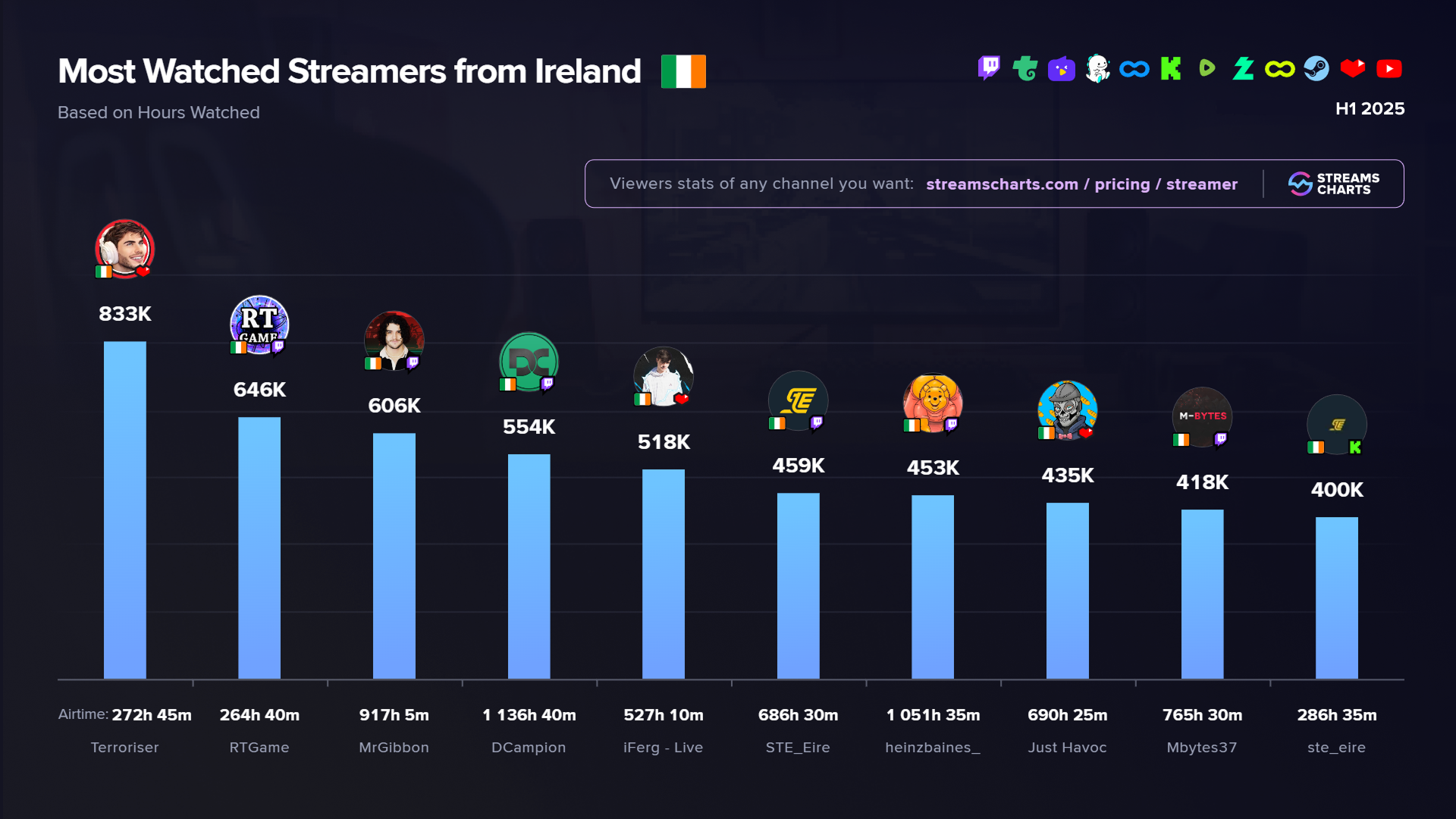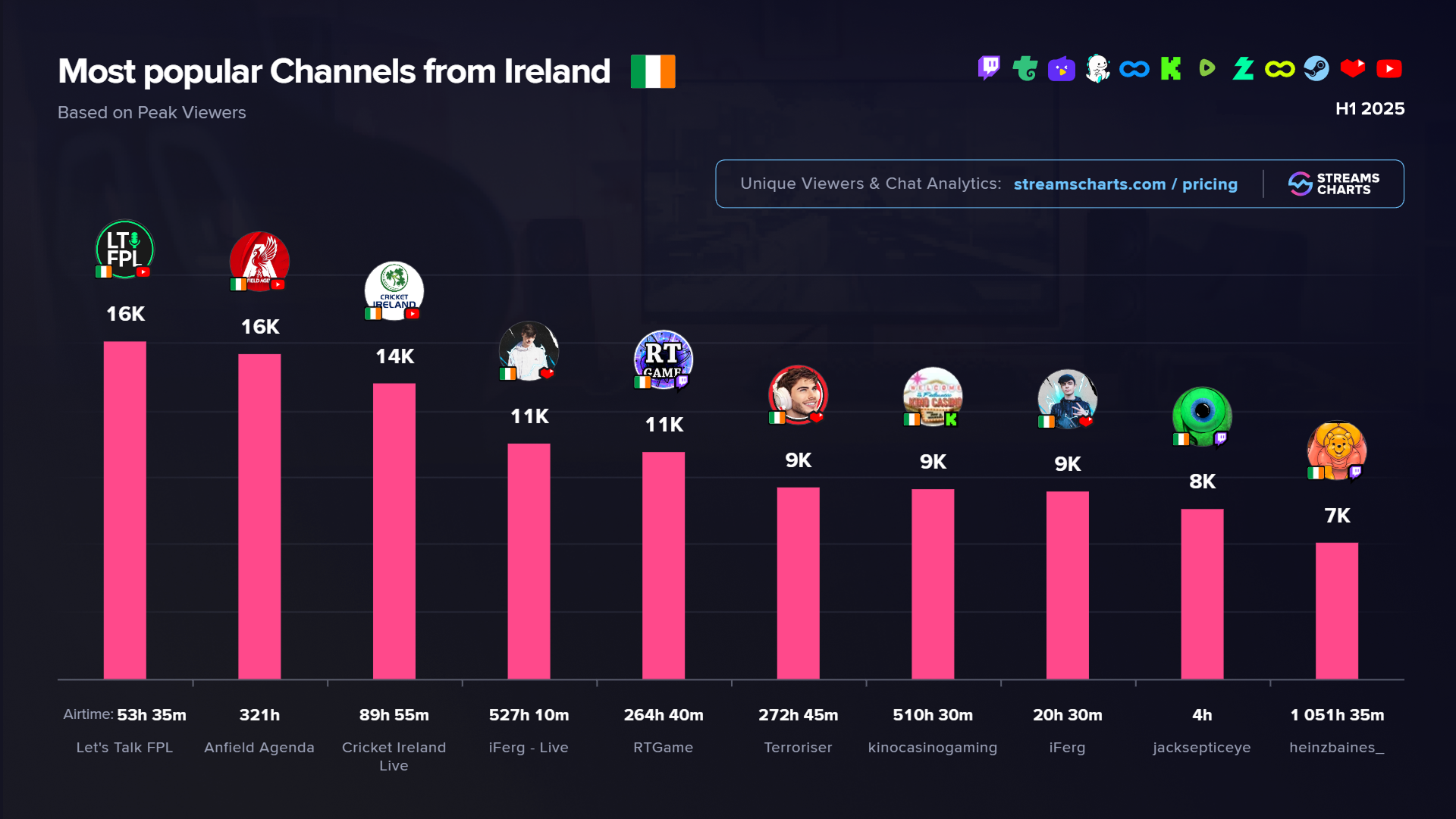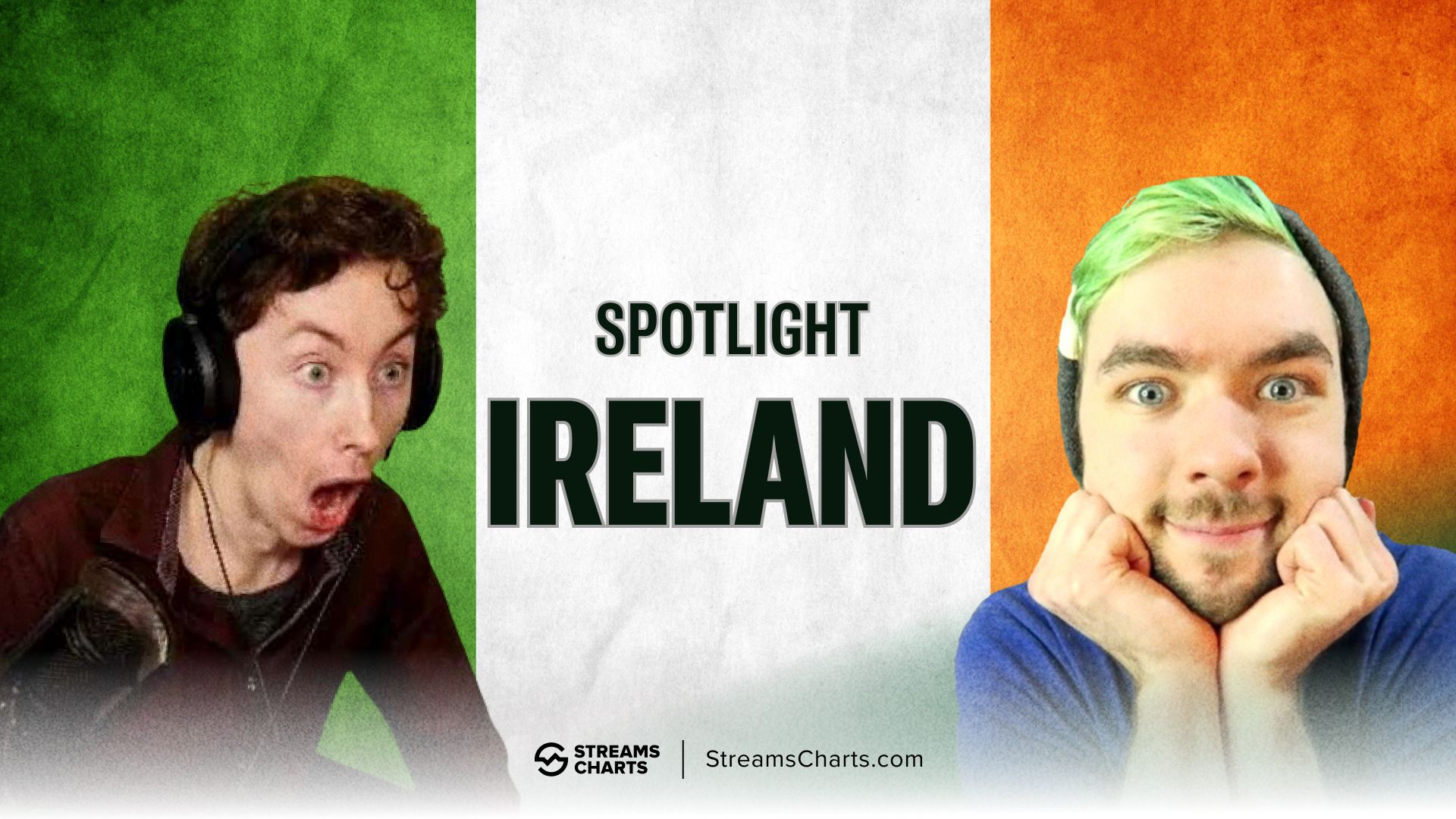While Ireland may not be the first country that comes to mind when thinking about global streaming powerhouses, the country has cultivated a unique livestreaming culture. From early grassroots broadcasting on YouTube to a new generation of Twitch and Kick streamers, Irish creators are finding international audiences while building deeply engaged communities at home.
One of Ireland’s greatest strengths in the digital era is linguistic. As an English-speaking country, Irish creators naturally operate in the world’s most widely used language. This gives them a built-in advantage: their content is instantly accessible not only to local audiences, but to millions across the UK, North America, Australia, and beyond.
While Ireland’s smaller population limits in potential in terms of livestreaming viewership, its tech-savvy and English-speaking youth are prime creators. Following the rapid modernization and digitalisation of Ireland throughout the 90s and 00s, its young population has seen livestreaming become a central pillar of how Irish audiences also consume entertainment.
This article traces the roots of livestreaming in Ireland, the boom years of YouTube in the 2010s, the further expansions into other platforms and mediums, and the present-day landscape of Irish livestreaming in 2025. Interested in other countries, like Ukraine, France, South Korea, or India? Check out our Spotlight: Article Series for further deep dives into the global community of livestreaming.
Fostering of online communities and gaming culture in the 2000s
In the early 2000s, Ireland was still catching up with other European countries in its broadband rollout. Dial-up connections were common for many households during this time, inhibiting the adoption of high-bandwidth online activities such as livestreaming and online gaming. However, as broadband slowly became more widespread and common, Ireland’s youth were quick to embrace online video and entertainment.
Taking a slight step back, in the late 90s, a postgraduate student at the National University of Ireland Galway created an online forum for discussion around the popular game Quake. Initially hosted on quake.ie, the service rapidly grew attention and users, and eventually, a decision was made to expand outside purely gaming content. The platform first known as Cloud Boards, later and more famously known as boards.ie, became the go-to forum for online discussion in Ireland. In fact, the site is still operational, although reportedly experiencing financial difficulties.

Boards.ie was a staple of Irish internet culture for decades
This shift from gaming-specific content into a wider, mainstream appeal as the service’s audience grew reflects the history of many other livestreaming platforms. Just as quake.ie slowly grew and evolved into boards.ie, platforms such as Twitch evolved from hosting almost exclusively gaming content into a host of diverse streams spanning all corners of entertainment.
Boards.ie was the original online platform for people in Ireland to search for online entertainment, community, and discussions. One of the most obvious precursors to the modern livestreaming industry were “shoutcast servers”. These functioned similarly to internet radio, allowing users to livestream with low bandwidth and sync the broadcast with an esports game. This functional, pragmatic method mirrors the current esports phenomenon of co-streaming, giving viewers countless broadcast options and personalities to pick from.
Rapid growth of diverse video creators in the 2010s
If the 2000s were about building community, the 2010s were Ireland’s breakout decade on YouTube, and increasingly, in livestreaming. One of the brightest sparks from the early days was Seán “Jacksepticeye” McLoughlin, whose Let’s Plays and high-energy style propelled him to stardom, where he still maintains his presence as a global entertainer. He has collaborated with star creators from the US like Mark “Markiplier” Fischbach, who coincidentally also has his own Irish heritage.
Alongside Jacksepticeye, other popular creators who emerged in the 2010s include Daniel “RTGame” Condren, Kevin “Call Me Kevin” O’Reilly, Daithí “Nogla” De Nógla and Brian “Terroriser” Hanby. These five Irish creators are also known well for collaborating with each other, calling themselves the “Irish Lads”, but they have also worked heavily with creators from North America to reach a wider audience.

Jacksepticeye is a world-famous creator and a forefront represenative for Ireland online
While the content between these creators are undoubtedly different, they have all largely focused on Let’s Plays or gaming content, and appeal to teenagers and older audiences. Crucially, the 2010s weren’t only about gaming content aimed at older audiences in the livestreaming scenes.
Throughout the 2010s, a family from County Meath began building their own YouTube empire. Scott “LittleLizard” Fitzsimmons and Ryan “TinyTurtle” Fitzsimmons began uploading videos to YouTube in 2012, slowly accumulating millions of subscribers and becoming some of the most popular family-friendly Minecraft content on the platform. Their younger sister, Kelly “LittleKellyPlayz” Fitzsimmons also created her own account, enjoying millions of subscribers herself. In 2018, the family made headlines when it became public the brothers had paid themselves €5,000,000 over three years.
Another completely different flavour of creator, David “Blindboy Boatclub” Chambers first found his fame as part of the satirical hip-hop duo The Rubberbandits, whose songs went viral in Ireland and launched them to national fame. Having build a reputation for sharp wit wrapped in absurd humour, Blindboy made the jump into podcasting and content creation in the late 2010s, bringing a young, socially conscious voice to Irish issues and politics. Currently, his podcast has exceeded 80 million listeners globally, and often received a million listeners per weekly episode. For many, Blindboy’s online content demonstrated how livestreaming could serve not just games-related content, but also deal with arts, politics, and social issues.

Blindboy was not the only Irish comedian to find a home in livestreaming; Chris “Francis Higgins” Tordoff is an Irish comedian, actor, and content creator who has slowly become a staple for Irish livestreaming. He
initially rose to fame with the Hardy Bucks mockumentary, from which his role of Francis Higgins is still preserved with his online content presence. Over the years, Tordoff’s increased livestreaming activity and recognizability among Irish youth have seen his stream become a stable part of local Irish livestreaming.
Throughout the 2010s, independent Irish creators expanded into all corners of the industry, finding both audiences at home and abroad. From family-friendly Minecraft content to mental health and social issue debates, some of these creators appealed to international audiences around the globe — others instead appealed to a local Irish audience, building up a small, reliable following in a wildly dynamic industry.
Taken together, these examples highlight the remarkable range of Irish online creativity that emerged during the 2010s. From Irish gaming YouTubers and Twitch streamers, to family-friendly Minecraft entertainment, to Blindboy’s socially engaged commentary, Irish creators proved that livestreaming and digital platforms could support every kind of voice. What began as a handful of gaming channels quickly evolved into a dynamic and multifaceted ecosystem, where comedy, politics, family content, and esports could all thrive side by side.
Further livestreaming activity in Ireland
While gaming was the entry point for most livestreaming activity, by the late 2010s, livestreaming had become a mainstream format in Ireland. Traditional media and grassroots communities alike began to explore its potential.
National broadcasters RTÉ and companies like Virgin Media Ireland experimented with livestreaming news clips and special events on YouTube. However, independent media outfits remain more popular in livestreaming with Irish audiences, and these expansions did not find solid ground on YouTube. Sports content remains popular, however, and this could remain a potential avenue for media companies in the future of livestreaming.
Although Ireland’s esports ecosystem has historically lagged behind bigger European hubs, recent years have seen notable progress. Titles like Counter-Strike: Global Offensive, Valorant, and FIFA have built competitive communities, often livestreamed on Twitch. While Ireland hasn’t yet produced a globally dominant esports organization, individual Irish players have found success abroad, and many Irish esports production talent have found work in top-tier European esports circuits.
State of Irish Livestreaming in 2025
As of 2025, livestreaming in Ireland is a vibrant and diversified landscape; while Twitch remains an industry-leader with YouTube Live following close behind, things are not as static as they may seem. With new platforms arising and creators experimenting with multiple platforms, the Irish livestreaming scene is shaking up considerably.
Twitch remains the platform with the widest reach among Irish channels. Nearly every well-known Irish livestreamer maintains a presence on the platform, although multicasting is becoming more common in recent times. The Amazon-owned platform accumulated for most Irish channel viewership this year.
YouTube remains the second fiddle for Irish creators. While some channels have found their niche on YouTube Live, many of the most-watched options on YouTube are the less-watched multistream for a creator already broadcasting to Twitch. Nevertheless, the platform holds a steady audience and a particularly strong foothold with mobile games and younger audiences.
Kick is beginning to see traction in Ireland, having adopted some creators with its lucrative plans for streamers. While not many Irish creators are active on the platform in total, some of them brought significant audiences with them already.
Between these three major platforms, the top games for Irish livestreaming audiences show a sports-forward audience, which is also tuned into current livestreaming and gaming trends. Mobile gaming content was also surprisingly popular, usually not ranking highly with Western audiences.

Slightly dissimilar from other audiences, Education topped the rankings for most-watched categories among Irish channels. This category was propped up thanks to religious broadcasts, which have found ground in some regions across the globe on YouTube in recent years — a trend kicked off by the COVID-19 pandemic lockdowns.
Just Chatting was also highly popular with Irish channels, like the rest of the globe, and Grand Theft Auto V, Minecraft, and EA Sports FC 25 made up some of the other typical titles on this ranking. The Sports category in particular enjoyed significant viewership on Irish channels; this category featured many Irish creators focused on football content coverage, like Anfield Agenda and Let’s Talk FPL.
DayZ and Call of Duty Mobile are two of the more niche appearances in this top ten, alongside the role-playing content of No Pixel RP (GTA). While nicher categories on a wider, global scale, these livestreaming phenomena were loyally followed and consumed by Irish viewers.
Some of these categories, such as Just Chatting, received a significant following on Kick. The neon livestreaming platform is developing a minor audience with these viewers, with some of the top channels among Irish viewers represented on Kick.


Most watched and most popular Irish streamers for H1 2025
Across YouTube and Twitch, top Irish content creators like Terroriser and RTGame continue to dominate the rankings thanks to their multi-million followerships. Alongside these older names, newer creators like MrGibbon, STE_Eire, and DCampion have built audiences on more current trends, such as Grand Theft Auto V livestreams.
Other top creators by watch time included EA Sports FC streamers like heinzbaines_ and Mbytes37 and iFerg - Live, the live broadcast channel of popular Northern Irish mobile gaming creator Luke "iFerg" Fergie.
In terms of raw concurrent audience, football-focused discussion channels dominated the top of the ranking, closely followed the Cricket Ireland Live channel. Past these sports peaks, the remainder of the ranking was made up by Ireland’s most popular creators, including some like jacksepticeye, who only streamed for four hours total in 2025 so far.
Conclusion
As an English-speaking country, Ireland’s population is naturally set to assimilate with larger, international audiences. Many creators over the years have leveraged this to great effect, finding large audiences abroad, but as Ireland continues to develop its own industry, more and more creators are appealing to a uniquely Irish flavor.
Ireland’s livestreaming story is one of rapid adaptation and cultural blending. What began in the 2000s with scattered LAN centers and forum-based communities has grown into a mature ecosystem spanning gaming, news, and esports. The country’s creators are not only entertaining domestic audiences, but also exporting Irish identity to millions worldwide.
With strong broadband penetration, a growing esports culture, and globally recognized creators leading the charge, Ireland is poised to continue contributing to the global livestreaming industry. Platforms evolve and viewer habits shift, but livestreaming in Ireland is clearly a central part of cultural and entertainment.
